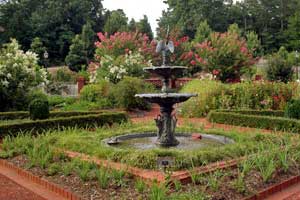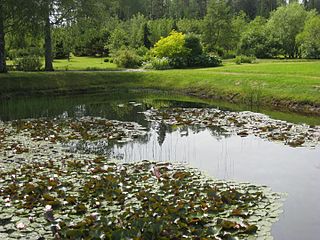Related Research Articles

An arboretum is a botanical collection composed exclusively of trees of a variety of species. Originally mostly created as a section in a larger garden or park for specimens of mostly non-local species, many modern arboreta are in botanical gardens as living collections of woody plants and is intended at least in part for scientific study.

The Connecticut College Arboretum is a 300 ha arboretum and botanical gardens, founded in 1931, and located on the campus of Connecticut College and in the towns of New London and Waterford, Connecticut, United States.

The University of California Botanical Garden is a 34-acre botanical garden located on the University of California, Berkeley campus, in Strawberry Canyon. The garden is in the Berkeley Hills, inside the city boundary of Oakland, with views overlooking the San Francisco Bay. It is one of the most diverse plant collections in the United States, and famous for its large number of rare and endangered species.

The University of Delaware Botanic Gardens are botanical gardens and an arboretum located on the campus of the University of Delaware, in Newark, Delaware, United States. The gardens are open to the public without charge.

The Donald E. Davis Arboretum, in Auburn, Alabama, United States, is a public native plants museum, and botanical arboretum with educational facilities, event spaces, and a conservation program. Its grounds, covering 13.5 acres of Auburn University's campus, include cataloged living collections of associated tree and plant communities representative of Alabama's ecosystems, among which is mixed oak forest, carnivorous bog, and longleaf pine savanna. The living collections include more than 1,000 plant types, including 500 different plant species, with over 3,000 cataloged specimens. The Arboretum contains over a mile (2 km) of interwoven walking trails that meander through various southeastern biotopes.

The Salisbury University Arboretum, formerly known as the Salisbury State University Arboretum, is an arboretum on the campus of Salisbury University, 1101 Camden Avenue, Salisbury, Maryland.
University of Nevada, Reno Arboretum is a state arboretum located across the campus at the University of Nevada, Reno in Reno, Nevada.

Bickelhaupt Arboretum is a non-profit arboretum located in Clinton, Iowa. It is open dawn to dusk daily without charge.

Nichols Arboretum, locally known as the Arb, is an arboretum operated by the Matthaei Botanical Gardens and Nichols Arboretum (MBGNA) at the University of Michigan. Located on the eastern edge of its Central Campus at 1610 Washington Heights in Ann Arbor, Michigan, the Arboretum is a mosaic of University and City properties operated as one unit. The arboretum is open daily from sunrise to sunset with no charge for admission. The Huron River separates a northern section of the arboretum's floodplain woods; the railroad marks the northern border.

The JC Raulston Arboretum is a 10-acre (40,000 m2) arboretum and botanical garden administered by North Carolina State University, and located in Raleigh, North Carolina. It is open daily to the public without charge.

Tyler Arboretum is a nonprofit arboretum located at 515 Painter Road, Middletown Township, Delaware County, Pennsylvania. It is open daily except for major holidays; an admission fee is charged to non-members.

The Sir Harold Hillier Gardens is an arboretum comprising 72 hectares accommodating over 42,000 trees and shrubs in about 12,000 taxa, notably a collection of oaks, camellia, magnolia and rhododendron.

The State Botanical Garden of Georgia is a botanical garden of 313 acres in the United States, with a conservatory operated by the University of Georgia. It is located at 2450 South Milledge Avenue, Athens, Georgia.

The Arboretum de Balaine is a historic arboretum located in Villeneuve-sur-Allier, Allier, Auvergne, France. It is open daily in the warmer months; an admission fee is charged.
The Seed Herbarium Image Project (SHIP), is an initiative of the Arnold Arboretum of Harvard University to create a web-based repository of high-resolution digital images documenting the morphology of woody plant seeds and selected fruit structures. Headquartered at the Arboretum’s Dana Greenhouse facility and coordinated and photographed by curatorial assistant Julie McIntosh Shapiro, the Seed Herbarium Image Project supports the work of educators and professionals in horticulture and the botanical sciences, particularly in conservation research and management of rare and endangered species. The digitized images of seeds offer an important new aid for teaching seed identification—a fundamental skill in plant propagation, hybridization, and distribution—and serve as a resource for nurserymen, horticulturists, botanical curators, taxonomists, ecologists, and the general public. SHIP also provides an online resource for botanical institutions and nurseries to verify their collections and inventories. SHIP is made possible through the generous support of the Stanley Smith Horticultural Trust, Cabot Family Charitable Trust, and the J. Frank Schmidt Family Charitable Foundation.

Wojsławice Arboretum is an arboretum, located in Wojsławice, Dzierżoniów County, Lower Silesian Voivodeship, in south-western Poland. It occupies an area of 62 ha.

The Botanischer Garten der Universität Tübingen, also known as the Botanischer Garten Tübingen or the Neuer Botanischer Garten Tübingen, is a botanical garden and arboretum maintained by the University of Tübingen. It is located at Hartmeyerstrasse 123, Tübingen, Baden-Württemberg, Germany, and open daily.

Mt. Cuba Center is a non-profit botanical garden located in Hockessin, Delaware, near Wilmington, in the gently rolling hills of the Delaware Piedmont. Its woodland gardens produce some of the most spectacular displays of wildflowers in the mid-Atlantic region. Mt. Cuba is open to the public from April through November for general admission, guided tours and special programs. Education courses, including a Certificate in Ecological Gardening, are offered year-round.

Arboretum Wespelaar is an arboretum in Wespelaar, Belgium.

Kalsnava Arboretum is an arboretum in Kalsnava Parish, Madona Municipality, Latvia.
References
- ↑ "About the Plant Collections Network". American Public Gardens Association. Retrieved March 13, 2016.
- ↑ "Nationally Accredited Plant Collections – How To Apply | American Public Gardens Association". publicgardens.org. Retrieved March 17, 2016.
- ↑ "American Public Gardens Association". publicgardens.org. Retrieved March 17, 2016.
- ↑ "Cypripedioideae | American Public Gardens Association". publicgardens.org. Retrieved March 24, 2016.